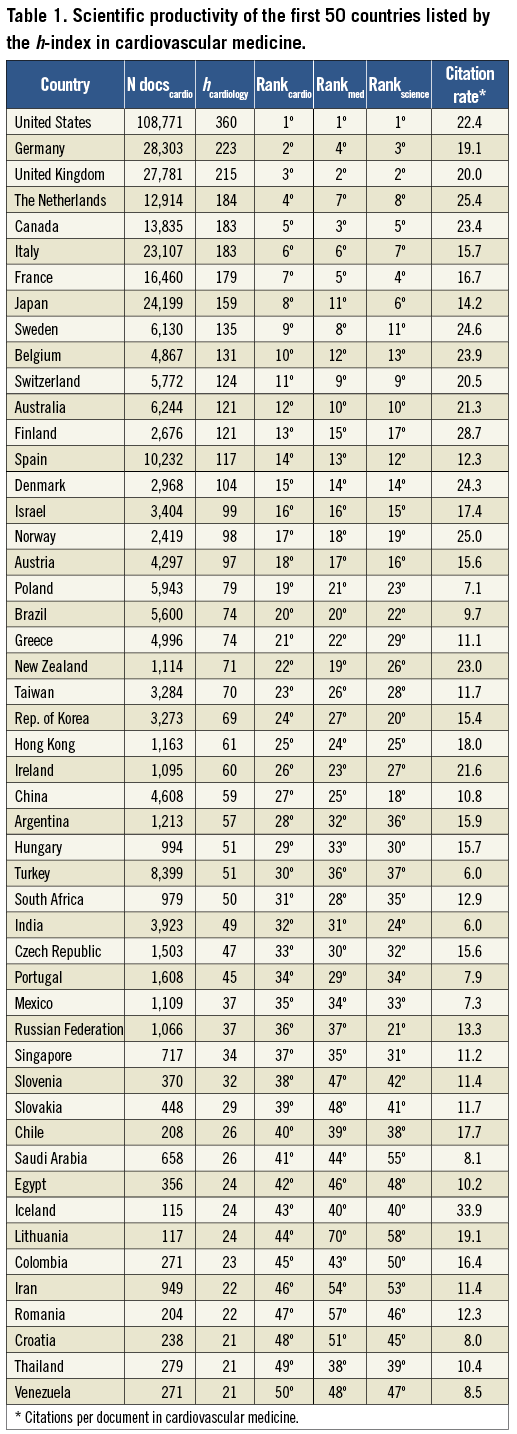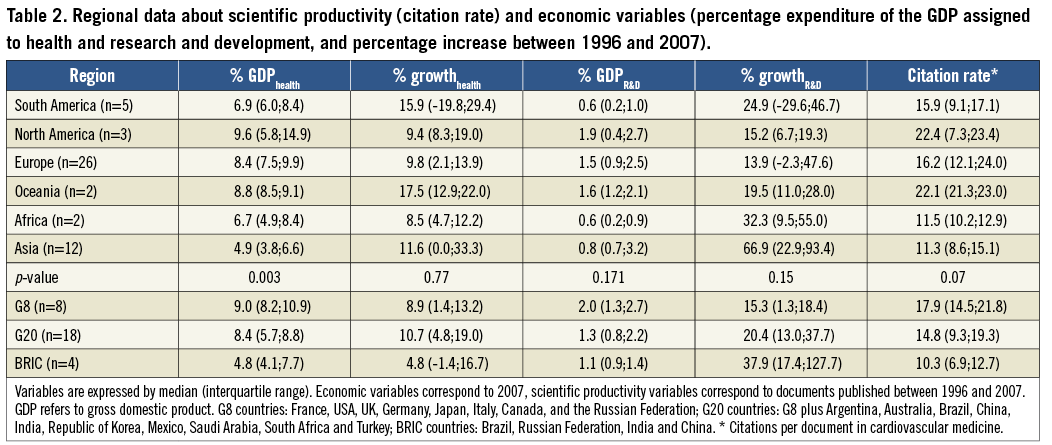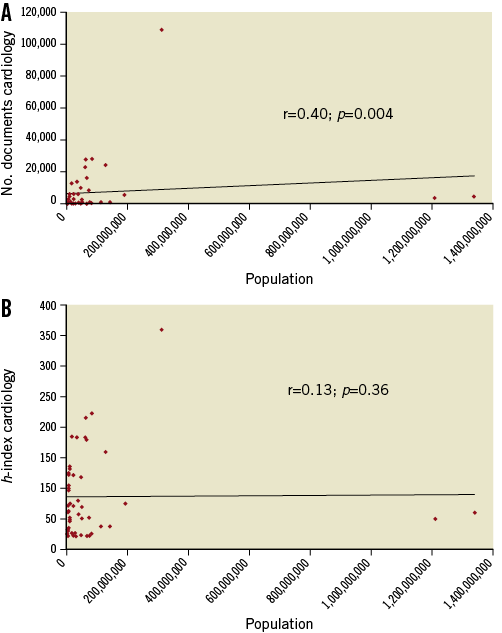Abstract
Aims: We sought to explore whether global and regional scientific output in cardiovascular medicine is associated with economic variables and follows the same trend as medicine and as science overall.
Methods and results: We registered the number of documents, number of citations, citations per document and the h-index for the first 50 countries according to the h-index (a measure to evaluate both the productivity and impact of the publications) in cardiovascular medicine. Economic variables (gross domestic product [GDP] per capita, % expenditure of the GDP in research and development [R&D] and health) were obtained from the World Bank, the UNESCO, and the World Health Organization. In total, the scientific output in cardiology showed the same position as in medicine and science overall (mean difference vs. medicine –0.9±5.3º, p=0.25 vs. science –0.7±5.3º, p=0.39). We found significant correlations between the h-index and the % GDP expenditure in R&D (r=0.67, p<0.001), and the % GDP expenditure in health (r=0.71, p<0.0001). Overall, there was a 21.4% (interquartile range 3.7; 55.0) increase in the % GDP expenditure in R&D between 1996 and 2007. Emerging economies showed the larger growth in % GDP expenditure in health and R&D.
Conclusions: The global situation of scientific output in cardiovascular medicine is highly polarised and closely related to economic indicators. Emergent economies, with higher rates of GDP growth and increasingly larger expenditures for R&D and healthcare, are expected to show a visible escalation in the scientific global picture in the near future.
Introduction
The United States of America (USA) produces 20% of the world research. Nevertheless, in the past five years the USA has witnessed an approximate 5% loss of the global share of publications. The traditional leaders in research account for 59% of all spending on science globally. However, similar to the USA, they have all lost a significant share of the global authorship during the past decade1-3.
The field of cardiovascular medicine has not been an exception in terms of impressive growth during the past decade. The answer to the question as to whether global and regional scientific output in cardiovascular medicine is associated with economic variables and follows the same trend as medicine and as science overall remains unknown.
Methods
The Scimago Journal and Country rank (http://www.scimagojr.com) public access database, which includes journals and country indicators powered by Elsevier’s B.V. Scopus database, was searched for data between 1996 and 2010. We registered the number of documents, number of citations, citations per document (for citable items including original articles, reviews, and conference papers) and the h-index for the 50 countries with the highest h-index in cardiovascular medicine (hcardiology), according to the Scopus® Classification. The citations per document were defined as the average citations (of all times) per document of documents published during the period 1996-2010. The Hirsch index (h-index) is a measure to evaluate both the productivity and the impact of the publications of an individual, university, department, or country, and takes into account the scientist’s most frequently cited papers and the number of citations that such manuscripts have received4,5. A given scientist has an h-index of h, if he/she has published h papers, each of which has received h citations. We calculated the h-index for cardiovascular medicine (hcardiology), medicine overall (hmedicine), and science overall (h science) using the SciVerse’s Scopus database. Manuscripts with multiple authors from different countries were adjudicated as one document per country involved, regarding the nationality, but as a single item regarding the total manuscript count.
The 2007 gross domestic product (GDP) per capita (in US dollars) was obtained from the World Bank (http://www.worldbank.org), except for Taiwan (International Monetary Fund, 2008). The percentage of the GDP expenditure in R&D for the years 1996 and 2007 was obtained from the United Nations Educational, Scientific and Cultural Organization (http://www.unesco.org). We also evaluated the percent GDP expenditure in health, obtained from the World Health Organization, where the total expenditure in health is the sum of public and private spending in health (www.who.int). We further evaluated the relationship between economic indicators and scientific output.
Statistical analysis
Discrete variables are presented as counts and percentages. Continuous variables are presented as mean±SD or median (interquartile range), as indicated. Comparisons among groups were performed using Kruskal-Wallis tests. Agreement between continuous variables was assessed using Bland-Altman plots. Correlations between variables were evaluated using the Spearman’s rho correlation coefficient. A two-sided p-value of less than 0.05 indicated statistical significance.
Results
GLOBAL AND REGIONAL RESULTS
Between 1996 and 2010, the first 50 countries according to the h-index in cardiology produced 361,450 documents in cardiology, with a mean 15.8±6.4 citations per document. Table 1 and Table 2 portray the number of documents, h-index, and the number of citations per document for each continent and for every country. The overall population was related to the number of documents in cardiology (r=0.40, p=0.004) but not to the hcardiology (r=0.13, p=0.36) (Figure 1).



Figure 1. Relationship between the numbers of documents published in cardiovascular medicine and the population (A); and between the h-index in cardiovascular medicine and the population (B).
The USA led the rankings in cardiology, medicine, and in science as a whole. During the reported period, the USA produced 108,771 documents on cardiology (30% of global share), and 1,516,076 documents on medicine (29% of global share). In the same line, the G8 nations produced 243,522 documents in cardiology (67% of the global share), and 3,366,465 documents on medicine (64% of the global share).
SCIENTIFIC PRODUCTIVITY IN CARDIOLOGY VS. MEDICINE AND SCIENCE OVERALL
The total number of documents on cardiology accounted for 6.2±2.2% of the total number of documents published in medicine overall, whereas the total number of citations received by documents on cardiology accounted for 6.6±2.2% of the total number of citations in medicine overall.
Aside from rare exceptions, the scientific output in cardiology showed almost the exact same position as in medicine and science overall (mean difference vs. medicine –0.95±5.1, p=0.20 vs. science –0.60±5.3, p=0.43). The Bland-Altman plot (Figure 2) portrays the close agreement between the rankings in cardiology and science.

Figure 2. Bland-Altman plot depicting the agreement between rankings in cardiovascular medicine and in science overall.
RELATIONSHIP BETWEEN THE SCIENTIFIC OUTPUT AND ECONOMIC VARIABLES
There was a significant correlation between the % GDP expenditure in R&D and both the hcardiology (r=0.67, p<0.001) and the number of documents (r=0.52, p<0.0001). In parallel, we found a significant correlation between the % GDP expenditure in health and both the hcardiology (r=0.71, p<0.0001) and the number of documents (r=0.55, p<0.0001).
Overall, there was a 21.4% (IQR 3.7; 55.0) increase in the percent GDP expenditure in R&D between 1996 and 2007, and a 10.3% (IQR 3.2; 17.9) increase in the percent GDP expenditure in health. In turn, the BRIC countries showed a 37.9% (IQR 17.4; 127.7) and a 4.8% (IQR -1.4; 16.7) increase in their GDP expenditure in R&D and health, respectively, during the same period. The countries with the larger increases on R&D expenditure were mainly from Asia. China had a 152.6% increase in GDP spend in R&D, Singapore had an 84% increase, Hong Kong an 88% increase, and Israel a 74% increase. The USA showed an increase of 7% of their GDP expenditure in R&D and a 9% increase of their GDP expenditure in health. Similarly, the countries with the larger increases in their GDP expenditure on health were also mostly from Asia.
Discussion
The h-index has rapidly gained relevance in recent years as a measure to evaluate the scientific output of an individual, university, society, or country. Indeed, European university hospitals often use the h-index as a tool to assess the scientific merits of individuals to obtain academic positions or to qualify as professors. Aside from its recognised limitations, the h-index is probably the most simple and yet precise means to assess the scientific productivity of individuals5. The weakness of the simple computation of the number of published documents is portrayed by the significant correlation we have found between this variable and the population, whereas no relationship was observed between the latter and the h-index.
Additional observations can be made from our results. Firstly, we found that the leading role of the USA in the global economy and in research is reproduced in the cardiovascular field, producing 30% of global share. Likewise, the polarisation of scientific productivity is further demonstrated by the fact that the G8 nations produced 68% of the global share.
It is noteworthy that the scientific output in cardiology followed an almost linear relationship to the output in medicine and in science as a whole. Such an analogous situation in different fields could be due to political, educational and cultural decisions of governments that might have a larger weight than individual efforts in specific fields.
We observed a significant relationship between economic indicators and scientific productivity in cardiology. Overall, these findings could potentially be attributed to the fact that the wealth of nations has a direct impact on scientific output, by allowing scientists and physicians to carry out research in parallel to their clinical work by means of an increased percentage of GDP expenditure assigned to health and R&D. Indeed, a worrisome finding was the fact that the regions with the lowest GDP per capita also had the lowest percentage of GDP expenditure assigned to health and R&D, both indices highly related to scientific productivity.
Since the GDP as well as the percentage GDP expenditure on health and R&D are highly related to scientific productivity, it can be expected that emerging countries with higher growth rates of such economic variables will experience a significant growth in their scientific productivity in cardiology. However, it is hard to establish what should be the time requested for a sustained economic growth to generate visible improvements in scientific output.
Limitations
The analysis presented was based mainly on the h-index. Therefore, limitations of this index also apply to the limitations of our manuscript6. Secondly, we did not calculate the number of self-citations, which might increase the author’s own h-index. Finally, due to the lack of completeness of current worldwide economic databases, the most updated economic variables analysed were those of 2007.
Conclusions
The global situation of scientific output in cardiovascular medicine is highly polarised and closely related to economic indicators. However, emergent economies with higher rates of GDP growth and increasingly larger expenditures on R&D and healthcare are expected to show a visible escalation in the scientific global picture in the near future.
Conflict of interest statement
The authors have no conflicts of interest to declare.

